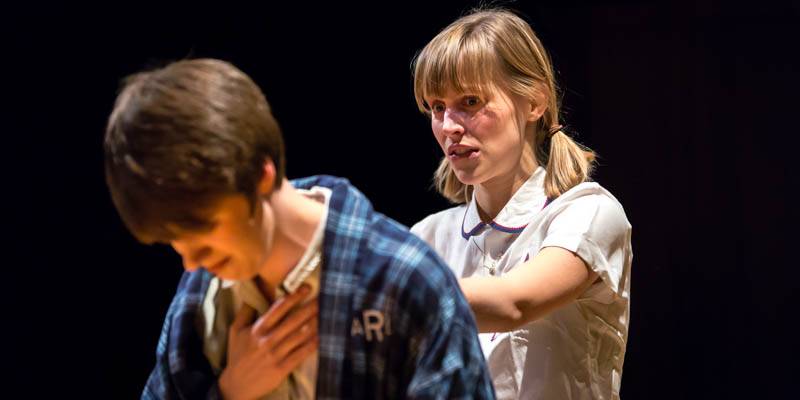Last Friday night, I had recently completed a pretty enjoyable interview with new-to-us director Latrelle Bright, and in doing so, had reacquainted myself with old friends I met when I first read Paul Zindel’s works in the mid-nineties. Pleasant feelings of expectation filled me as I entered the Station — I was sure I was well-prepared for the adventure ahead. With a script that was focused and more direct than the wandering novels I remember, and five talented actresses who were fully immersed in their characters, The Effect of Gamma Rays on Man-in-the-Moon Marigolds was a wholly engaging night at the theatre.
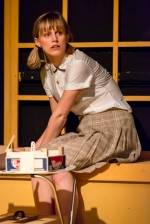 The first level of engagement was the seating, which was described to me as “in the round”. It could almost have been described as “on the set”, as the dressing filled in the gaps between audience chairs. The east and west walls have seats lined up along them, next to primary exits for the actors and some major areas of focus, like the dining room table or the rabbit’s cage. The south wall was most immersive, being just a dozen or so chairs literally breaking the fourth wall between the kitchen and the living room. To the north were the risers like usual, but the top two were curtained off as “upstairs” to which various characters escaped or were banished. I got a tip to sit either east or west, and I chose east, near Tillie’s window seat, but I think the better choice
The first level of engagement was the seating, which was described to me as “in the round”. It could almost have been described as “on the set”, as the dressing filled in the gaps between audience chairs. The east and west walls have seats lined up along them, next to primary exits for the actors and some major areas of focus, like the dining room table or the rabbit’s cage. The south wall was most immersive, being just a dozen or so chairs literally breaking the fourth wall between the kitchen and the living room. To the north were the risers like usual, but the top two were curtained off as “upstairs” to which various characters escaped or were banished. I got a tip to sit either east or west, and I chose east, near Tillie’s window seat, but I think the better choice 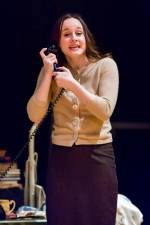 would have been west, as there were some major scenes during which the entire cast was facing away from me.
would have been west, as there were some major scenes during which the entire cast was facing away from me.
The stage was set well, with pieces of mid-century well-worn furniture, arranged comfortably like a house where people lived. I noticed the seemingly-random piles of books, while it seemed the tomes were just everywhere, Tillie had carefully chosen to stash them in areas where her mother wouldn’t notice. The piles of everything else, especially by the phone, hinted at the beginnings of hoarder, but not yet at intervention-level. Set designer Nicholas Schwartz and Propmaster Jacob Foster had me feeling right at home, which was crucial, with the action being at arm’s-reach.
I’ll admit, I was drawn in by Tillie’s opening monologue, which we discover is being delivered to a rabbit inside a home she thinks is un- or under-occupied. With only one or two other close-quarters performances under my belt, it was an unfamiliar experience for me to make eye contact with the actors, but it helped capture my attention right away. As audience, we know that she can’t possibly be talking to us, but well… we’re sitting in her living room and she’s looking right at us, emphatically describing how we’re all made up of stardust. Just try to stay disconnected and objective, sure.
Which naturally brings me to the acting. Five talented women bring these troubled characters to life, did I mention within coughing distance? Yeah, because that’s an extra layer of talent right there. Starting with their appearances, brunette Allie Wessel and blonde Aubrey Helene balanced each other effortlessly as tumultuous Ruth and innocent Tillie. Ms. Helene was especially notable for how believably she played the marvel and wonder whenever she got excited about science, I could tell these concepts truly filled the character with hope and awe.
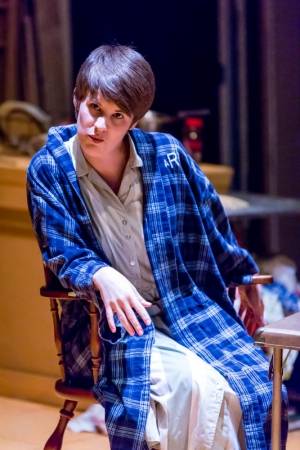 Rachel Rayburn as Beatrice, the girls’ mother nailed the bitter tone, the sarcasm, the capriciousness and despair of a jaded young mother finding herself older and stuck. She acted the part beautifully, charging every motion with the anger and spite she held in her eyes. An unfortunate circumstance of the staging, however, was the inability to use aging makeup or any other devices to make her look as tired as she sounded. When she had close scenes with the girls, it was difficult for me to think of her as their mother, when it was clear that there could only be a handful of years between them, and it did jostle me out of the performance once or twice. When Ruth and Beatrice started arguing, also, the volume got a little out of hand, it seemed that angry always equals loud in this house, and it was a little intense for me.
Rachel Rayburn as Beatrice, the girls’ mother nailed the bitter tone, the sarcasm, the capriciousness and despair of a jaded young mother finding herself older and stuck. She acted the part beautifully, charging every motion with the anger and spite she held in her eyes. An unfortunate circumstance of the staging, however, was the inability to use aging makeup or any other devices to make her look as tired as she sounded. When she had close scenes with the girls, it was difficult for me to think of her as their mother, when it was clear that there could only be a handful of years between them, and it did jostle me out of the performance once or twice. When Ruth and Beatrice started arguing, also, the volume got a little out of hand, it seemed that angry always equals loud in this house, and it was a little intense for me.
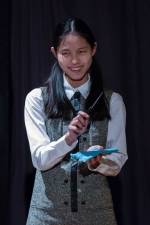 Intensity was present in all of the women, without a doubt. Xuan Li Leong’s …enthusiasm… about her (Janice Vickery’s) … “science project” was compelling enough to be unsettling, which is actually praise even though it feels kind of creepy. Nothing, however, nothing was as intense as Jude Love’s nearly-silent performance as Nanny, the elderly boarder. Even more painfully slowly and noisily than the opening scene of Sling Blade, Nanny drags her walker on set for the first time. Once seated, she’s confined to a chair, meaning she has to see, and react to, everything going on in the house. She takes it all in, and you see it all reflected in her face and her posture. Between those reactions and her character interactions, Ms. Love gives us all a good sense of just who Nanny is and what she thinks, even though her role is wordless.
Intensity was present in all of the women, without a doubt. Xuan Li Leong’s …enthusiasm… about her (Janice Vickery’s) … “science project” was compelling enough to be unsettling, which is actually praise even though it feels kind of creepy. Nothing, however, nothing was as intense as Jude Love’s nearly-silent performance as Nanny, the elderly boarder. Even more painfully slowly and noisily than the opening scene of Sling Blade, Nanny drags her walker on set for the first time. Once seated, she’s confined to a chair, meaning she has to see, and react to, everything going on in the house. She takes it all in, and you see it all reflected in her face and her posture. Between those reactions and her character interactions, Ms. Love gives us all a good sense of just who Nanny is and what she thinks, even though her role is wordless.
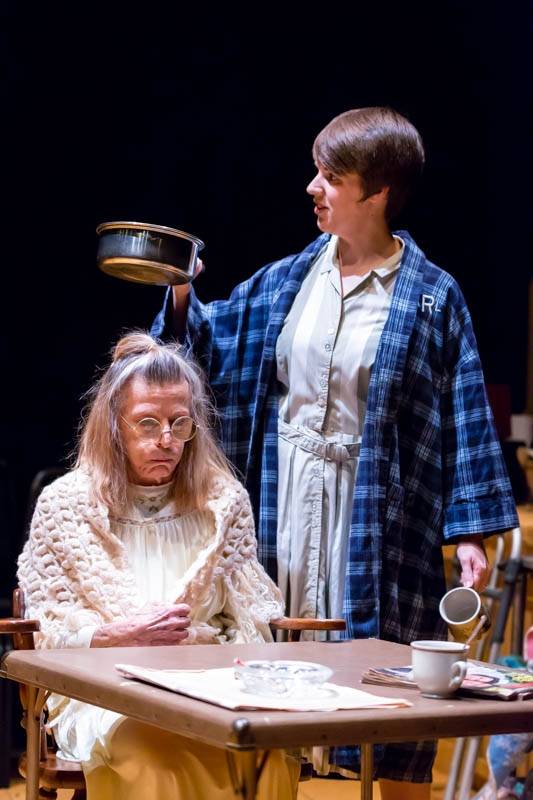
I’m glad that every aspect of this production was focused on reeling me in, because as I’ve said before, I’m not a big fan of the dysfunctional-family drama. This script definitely fits that trope, but like any box, it is a limited description. You bet there was shouting, and mocking, and lots of discomfort for both the cast and the viewers. The thing about family, though, functional or no, is that it is still connected. The very same access that allows a sibling to push the other’s buttons better than anyone else on the planet is the same thing that gives her exactly the right words of comfort when a relation is distressed. Marigolds demonstrates that in moments of calm, of crisis, and even when a supportive gesture becomes a nuclear bomb. If, like me, family-drama isn’t exactly your thing, you’ll still take away good from this play.
The Effects of Gamma Rays on Man-in-the-Moon Marigolds plays at the Station Theatre in Urbana for another two weeks: tonight through Sunday (December 9-13) and next Wednesday through Saturday (December 16-19). All shows are at 8 p.m., and Sunday-Thursday tickets are $10 each, while Friday or Saturday will cost $15.
Photos taken by Scott Wells.








